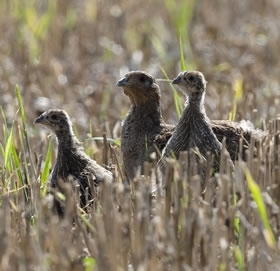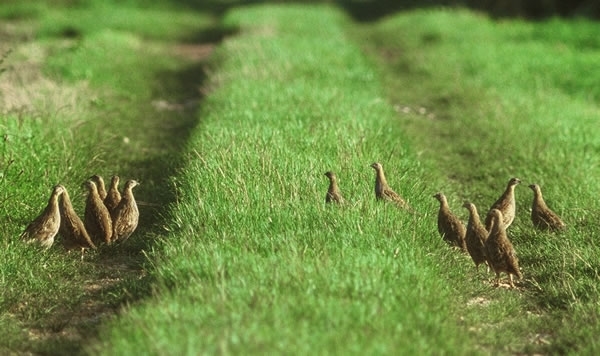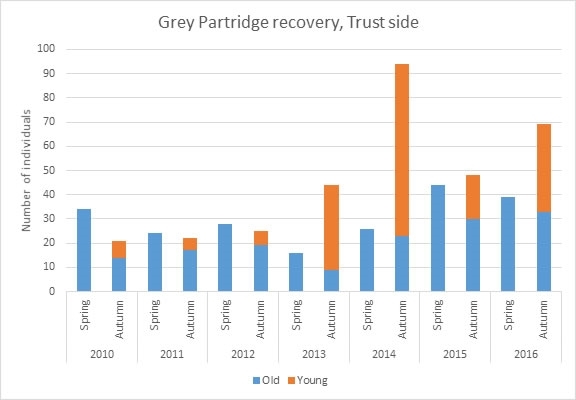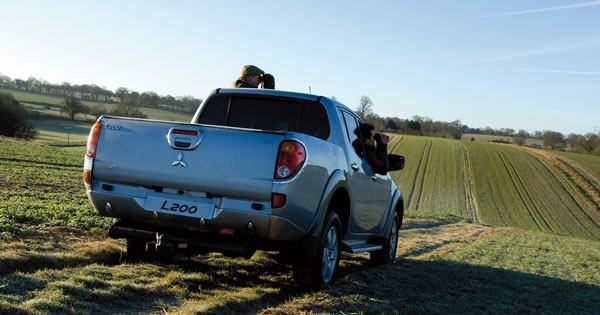 By Francis Buner, Senior Conservation Scientist
By Francis Buner, Senior Conservation Scientist
In my last blog I explained how to sex and age Grey partridges during an autumn count. Naturally, we applied all of that at our demonstration site at Rotherfield in early-mid September (download our new Guidelines on how to sex and age Grey partridges here).
And the counts are in: On the Trust’s managed demonstration area we counted 69 wild grey partridges (15 males, 18 females and 36 young from 10 successful broods). The spring count was 19 wild pairs.
Despite the highest amount of rainfall ever recorded at Rotherfield this June, the crucial hatching period for grey partridge broods, the partridges on the Trust side fared better than the national average this year.
This is thanks to an adequate amount of suitable high-quality partridge habitat (especially foraging cover), predator management tailored to a wild gamebird estate and favourable weather during the rest of the summer, when the replacement clutches hatched.

In fact, of the 10 broods counted, only one was a first brood, all others were broods hatched from second clutches (grey partridges lay a second clutch only if the first one failed). Although we fell short of our best autumn stock to date of just below 100 birds in 2014, we are very encouraged by this year’s count.
Despite the terrible weather in June, our autumn stock is higher than in the previous year, when overall during the breeding season weather was arguably better. Nevertheless, breeding success was very poor last year, presumably due to low insect numbers caused by an unusually cold spring (grey partridge chicks are highly dependent on insect-rich food during their first two weeks of life).

Keeping in mind that all the grey partridges at Rotherfield are the result of a re-introduction programme, this year’s autumn count is a positive result, despite the relatively low brood production.
To put it in an even more general context, the Rotherfield grey partridge re-introduction is the first ever known project to document recovery for the species from local extinction to a level that is close to being self-sustainable.
We believe that self-sustainability is achieved once the number of partridges counted in autumn is above 100 individuals on an area of around 500 ha, except in exceptionally bad years when the number could fall below that threshold level.
Also, sustainability exists only if 1) no releases are needed to maintain breeding numbers (no birds have been released on the Trust’s area since winter 2011/12), 2) the current level of management is maintained.
What we need is one good summer, and 20 pairs could easily produce more than 100 full-grown young next year!
A brief history of how we got to where we are today
The GWCT together with the Rotherfield estate have been working very hard to get where we are today, and it has certainly not been an easy stroll through ‘arable fields’. However, with the correct approach, enthusiasm and effort, partridge recovery from zero can be done.
In a nutshell, we started counting partridges at Rotherfield in 2004, when we launched our large-scale grey partridge re-introduction experiment to assess the best release strategy for reared birds. Once that project came to an end in 2006, the estate continued to release grey partridges following our Re-introduction Guidelines and to improve habitats under our guidance.

The whole estate was keepered by only one gamekeeper until 2010, when the Rotherfield demonstration project was initiated. This involved appointing the Trust’s gamekeeper Malcolm Brockless to manage half of the estate, the Trust side, and entering the Higher Level agri-environmental Scheme (HLS) in 2011. As a result, predator management and winter feeding were substantially intensified and suitable high-quality grey partridge habitat much improved and increased.
Initial grey partridge release stock was sourced from high-quality reared stock (bantam or parent-reared), mainly produced at the Trust’s own rearing field at Fordingbridge, supplemented by birds produced by Perdix Ltd, the only commercial provider of parent-reared birds in the UK.
The partridges were mostly released as autumn coveys (on average 75 birds in five coveys per year), but also through fostering of young to barren pairs (for details on how best to release grey partridges see here). The release of birds started in 2004 in what is now the core area for grey partridges at Rotherfield and was stopped in 2012.
After moderate breeding successes were recorded between 2008-10 (evidence of habitat suitability that is crucially needed before translocation of wild birds should even be considered), the fragile release population was supplemented by 30 wild translocated birds in winter 2011/12. No birds have been released on the Trust side since.
Please support our vital grey partridge work